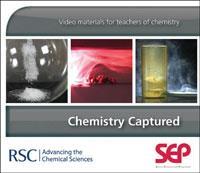Irfan Latif reviews this video resource
Peter Hollamby and Peter Edwards
London: Gatsby SEP 2010 | Pp43 video clips | £6 | ISBN9781907168024

This is an incredibly powerful piece of software developed by Cardiff University, the Royal Society of Chemistry and the Gatsby Charitable Foundation. It provides comprehensive video materials for a range of chemical reactions that will be covered at GCSE and A-level.
Some reactions now cannot unfortunately be undertaken in a school laboratory (which is a shame in itself) and this collection of high quality media allows these reactions to be viewed in class. Although videos are in no way a substitute for the real thing, which brings students closer to chemistry, this goes a long way to help overcome the problem.
The software can be used equally well as a tool to augment whole-class teaching and as an invaluable resource for individual students for revision and private study if uploaded on the school's VLE.
These short clips, which are on average about a minute in length (some are speeded up), are designed to stimulate interest and a curiosity about chemistry and provide a number of learning experiences not easily achieved in some school laboratories.
The quality of information in the form of model risk assessments is extensive and provides detailed notes relating to health and safety from both CLEAPPS and SSERC.
The quality of the media is excellent, catering for both high definition and low resolution and the makers have really captured the essence of the reactions. The scientific terminology is accessible and clearly depicted on the footage, labelling chemicals and equipment. However, there are no links to the internet which could have been useful.
This software will prove to be an indispensable resource for any chemistry teacher. It provides an array of inorganic chemical reactions which could add that extra dimension to a lesson. They can be used in a whole manner of different ways to show, explain, introduce, revise or expand a particular topic. The clips can be used after experiments or demonstrations (though hopefully not instead of) to bring out key teaching points or even show how an experiment should have happened! The software is very simple to use and would require very little in terms of introduction or training.
Overall this is a well polished piece of software which would be a welcome addition to any school chemistry department.
Links
- STEM library listing
- Chemistry Captured videos, hosted by Cardiff University






No comments yet